Reflections: Frederic A. Hopf
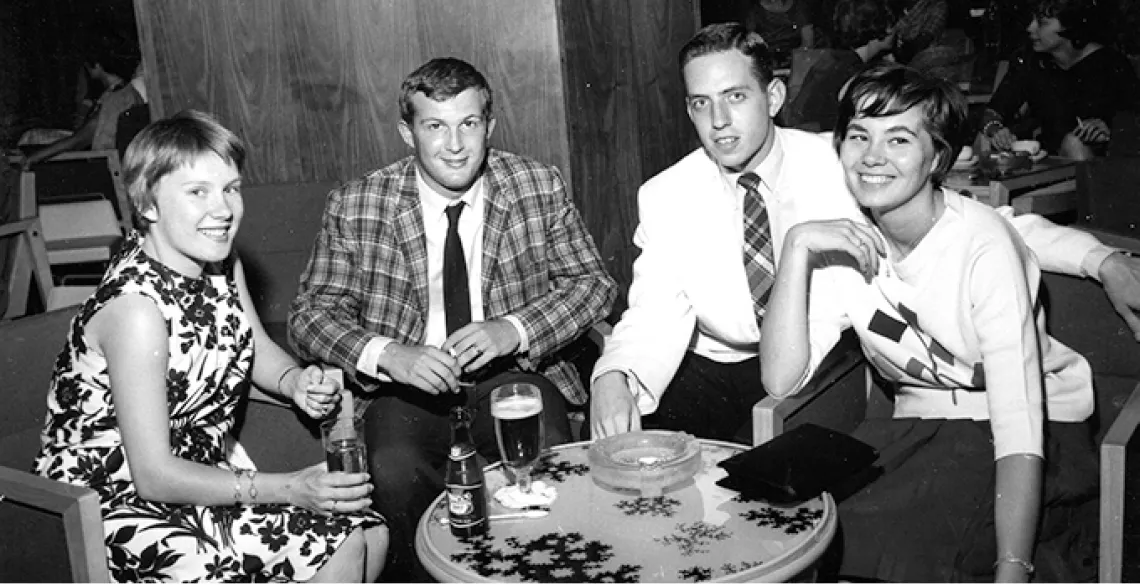
Sue and Fred Hopf (left) on way to Europe, July 1963.
Enthusiasm is one of the most powerful engines of success. When you do a thing, do it with all your might. Put your whole soul into it. Stamp it with your own personality.… Nothing great was ever achieved without enthusiasm.
(Ralph Waldo Emerson)
Motivated by a quest to continually gain new knowledge—and his characteristic, energetic approach to life—Professor Emeritus Frederic (Fred) A. Hopf excelled not only in the scientific fields of optics, ecology and evolutionary biology, but was also an accomplished singer, actor, birder, fisherman and desert gardener. Affectionally known to his students as Captain Chaos, Fred made scientific break-throughs in topics ranging from non-linear optics and lasers, to chaos, to Darwin’s theory of evolution.
Early Life
Born on March 6, 1942, to Clarissa and Fritz Hopf, Fred grew up in Ardmore, Pennsylvania, a suburb on the west side of Philadelphia. After graduating from Episcopal Academy, and scoring a near perfect score on the SAT, he was accepted to Yale University, his father’s alma mater. Upon graduating with a B.S. in Physics in 1964, Fred was awarded the Russell Henry Chittenden Prize—given to the B.S. candidate with highest rank in scholarship. His write-up in his senior yearbook highlighted academic excellence, a broad range of extracurricular activities and a commitment to family.
Physics Honor Major, Ranking Scholar, won Mathematics Prize, Phi Beta Kappa elected, Berzelius, Apollo Glee Club, Freshman Glee Club. Married Susan Heroy Bispham on February 18, 1961 in Gladwyn, PA. Future study: physics at Yale University.
Graduate School
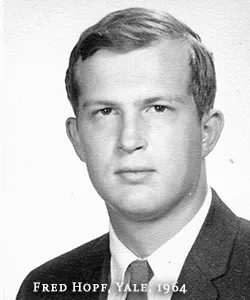
Continuing his studies at Yale in Physics, Fred earned a M.S. in 1966 and a Ph.D. in 1968. His thesis adviser was Professor Marlan O. Scully. While working with professor Scully and Nobel Laureate Willis E. Lamb, the first quantum theory of the laser was developed.
His thesis at Yale was “Theory of an Inhomogeneously Broadened Laser Amplifier.” It was one of the first codes to contain detailed propagation effects via a Lamb density formalism coupled with Maxwell equations. It was a tour-de-force and is still in use today. (Marlan O. Scully, Texas A&M and Princeton)
Early Career
When Fred graduated from Yale and after eight years in New Haven where both of his and Sue’s sons—Woody (1963) and Jonathan (1966)—were born, the family moved to Winchester, Massachusetts. Fred worked at Hanscom Air Force Base with a joint appointment at Massachusetts Institute of Technology (MIT).
Two years later, Fred had several offers of jobs in various cities, but President Richard Nixon had made major cuts in scientific funding so all but one rescinded. The only one left was from the Optical Sciences Center (OSC) at the University of Arizona. Fred thought it an appropriate choice since Marlan Scully had become a faculty member in the quantum optics group at OSC. (Willis Lamb later joined OSC as well.) In addition, there was a graduate student who needed assistance on his thesis topic project.
We came out in February of 1970 to visit Arizona. I remember thinking that Tucson looked very green for a desert. We stayed with Kathy and Steve Jacobs, and were wined and dined. Fred seemed pleased to be asked to come and enjoyed the work and the people he met. We went back to Massachusetts and packed up and returned to Arizona, towing a boat and bringing another boat on top of our van (the van that, later, acquired a Captain Chaos license plate). I really wasn't all that sure about living in Tucson, but we bought a very nice house with a beautiful view of the mountains and raised our two boys. It was a wonderful place to raise children, and we both ended up loving our work at the University. (Sue Hopf)
Research Collaborations
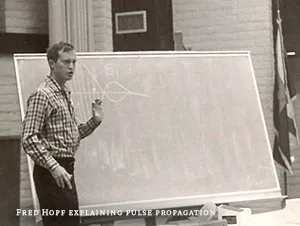
By the mid 1970s, the quantum optics group at OSC—Professors Fred Hopf, Steve Jacobs, Willis Lamb, Murray Sargent III, Marlan Scully and Rick Shoemaker—were known internationally for their innovative research. The group collaborated as a whole on a broad range of topics from X-ray lasers, to quantum field propagation, to free-electron lasers, and everything in between. Regent’s Professor Emeritus Pierre Meystre, who was a postdoc of professor Scully at the time, remembers “an extraordinary level of intellectual activity and ferment, terrific discussions at the blackboard in the hallways of the 6th floor, and Fred being ‘scary smart,’ with an uncanny talent to shoot down bad ideas and carry out good ones to success with amazing speed and creativity.”
At some point in the late 1970s, Fred became increasingly interested in chaos and bi-stability—an interest that stemmed in part from the fact that these subjects have a profound influence on the interpretation of modern physics. He found chaos in optics as well as in dynamical systems. In 1980, with professors Rick Shoemaker and Hyatt Gibbs, he demonstrated Ikeda’s prediction of a period doubling route to chaos, using a part-electronic, part-optics hybrid feedback experiment.
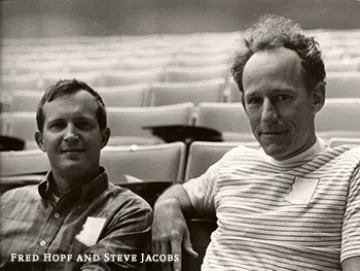
But quantum optics proved to be not quite enough for Fred. Known for his collaborative efforts in research, Fred soon became an adjunct professor of ecology and evolutionary biology. In the field of evolutionary biology, Fred saw the possibility that laser theory parallels evolution theory. He worked with University of Arizona professors Richard Michod and Harris Bernstein to pioneer the idea that distinctness of biologic species—in the absence of intermediate forms—emerges from a dynamic parallel to that in laser theory.
Internationally, Fred spent a sabbatical year at the Max Planck Institute for Quantum Optics near Munich, West Germany, where Pierre had moved after his postdoc—and where professors Scully and Sargent were regular visitors. In addition to the excitement over physics that always characterized interactions with Fred, Pierre also recalls “a couple of epic visits to the Oktoberfest, and Fred’s frustration at being unable to navigate his way through the German bureaucracy to obtain a local fishing license.” Fred also collaborated regularly with CSIRO in Australia and the Central Institute for Physics of the Hungarian Academy of Sciences. Other international collaborations included teaching a course in nonlinear optics in South Africa during one of the worst rains in then-recorded history—a trip that led to one of Fred and Sue’s most memorable vacations.
Fred had been invited to teach at a two-week summer school held in February 1981 at the Cathedral Peak Hotel, which is at the edge of the Great Rift Zone in eastern South Africa. After his first week there, I joined him, and once the summer school was over we spent two weeks touring Kruger National Park. The wet weather was a travel inconvenience and prevented us from getting wonderful photos, but the rains also turned the normally hot, tropical climate into a tolerably cool one. And because of the dark skies, the animals—usually seen only in early morning and late afternoon—were active throughout the day. We had an abundance of sightings of elephants, giraffes, lions, hyenas, hippopotamus, white rhinos and other mammals, plus 400 species of birds! (Sue Hopf)
So Many Interests, So Little Time
Stimulated by his studies of evolution and the diversity of species, Fred had a keen interest in the highly varied population of birds. An avid birder himself, Fred shared his expertise with fellow birders, as an active member of the Tucson Audubon Society. Professor Emeritus Rick Shoemaker recalled a period of time on the 6th floor of OSC when Fred would be called to the phone by his secretary running down the hall while shouting, “bird alert, bird alert!”
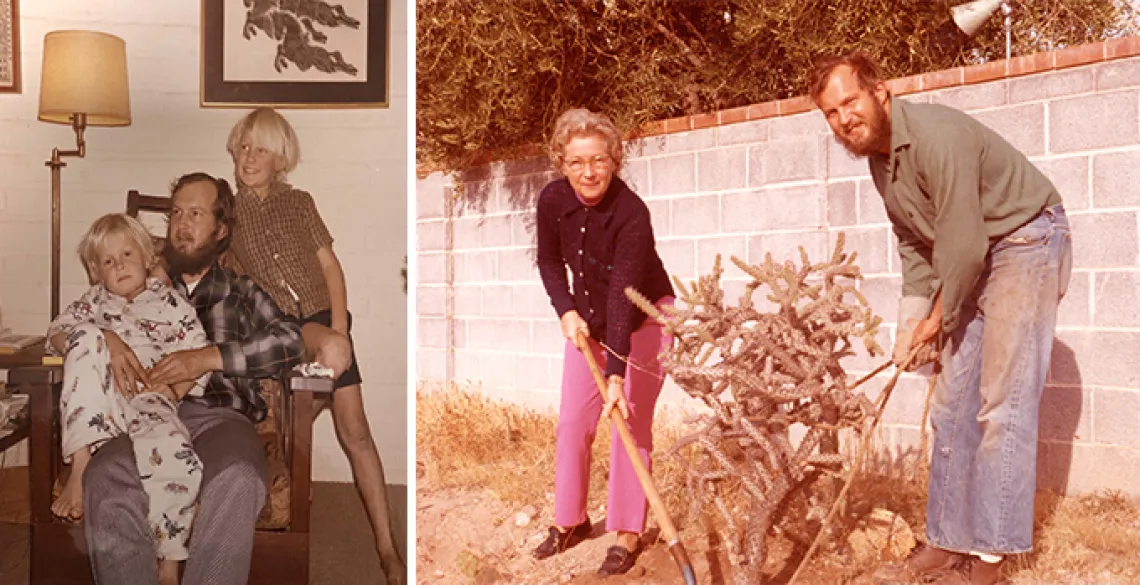
LEFT: Fred with sons, Jonathan (L) and Woody (R). RIGHT: Fred and his mother, Clarissa Hopf.
As strong as Fred’s love of birds, was his appreciation for musical theater—especially the works of William Gilbert and Arthur Sullivan. Fred’s beautiful singing voice, along with his flair for comedic acting, made him the perfect choice to portray several of the colorful characters in Gilbert and Sullivan operas. Fred and Sue—both members of the Tucson Gilbert and Sullivan Theater—performed in many shows, including The Pirates of Penzance, HMS Pinafore and Mikado. In addition to Fred’s participation on-stage, he also served as President of the Tucson Gilbert and Sullivan Theater for several years.
Professor Emeritus Steve Jacobs once told me that “Fred was a natural! Whether he was singing ‘A Policeman’s Lot is not a Happy One’ in The Pirates of Penzance, or portraying the ugly, Igor-like, swearing, one-eyed Dick Deadeye in H.M.S. Pinafore, watching him light up the stage was a real treat.”
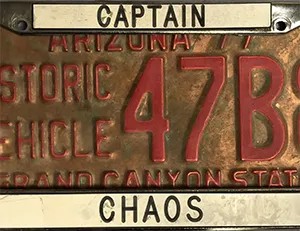
Legacy
Until his untimely death in 1989, Fred lived life to the fullest—making the most of every opportunity. In honor of Fred’s contributions to OSC, the library/reading room in the Meinel Building was named the Fred A. Hopf Library. This library supports the academic and research interests of the Center’s faculty, staff and students.
Eric Van Stryland, ’76 Ph.D., UArizona, and Emeritus Dean and Professor, CREOL, remembers Fred as “a very smart guy who was always friendly, approachable and willing to talk.” He tells this story to highlight Fred’s lasting impact on quantum optics…
A few years ago, I taught a course using Meystre and Sargent’s “Elements of Quantum Optics” book. There was a section that I was teaching that had some rather complicated derivation with some interesting changes of variables for performing integrals. One of these I simply could not follow and it appeared to be incorrect. I contacted Pierre Meystre, who was a friend of mine in grad school, and told him about my problem. He explained that they had taken this derivation from one of Fred’s publications—actually, it turned out to be part of his dissertation work. Pierre’s comment was “well, Fred was a smart guy, so it is probably correct.” In any case—while I never figured out the problem—the final answer turns out to be entirely correct. So, yes, Fred was a very smart guy!
